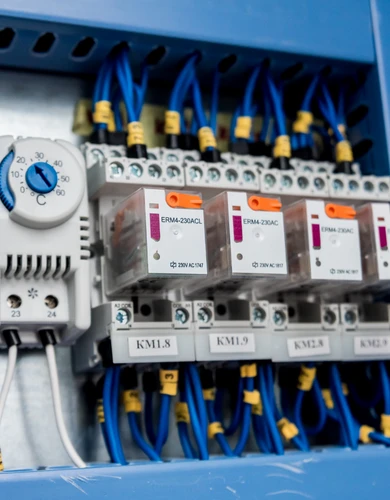Independent gas transporters
The UK’s gas distribution network was deregulated in the early 1990s, ending the monopoly of British Gas. Instead, multiple regulated companies were allowed to own, operate, and maintain different parts of this gas network.
During this transition, independent gas transporters (IGTs) were introduced to serve areas not covered by the main grid, ensuring gas supply to new and off-grid developments.
This article explores the role of IGTs, their benefits for businesses, and how Ofgem ensures they maintain fair pricing and high standards.
Contents
- What are independent gas transporters (IGTs)?
- What is the role of an independent gas transporter?
- Major UK independent gas transporters (IGTs)
- How to identify an independent gas transporter
- Regulation and pricing of independent gas transporters
- Connecting to an independent gas transporter
What are independent gas transporters (IGTs)?
Independent gas transporters (IGTs) are private companies operating outside the British mains gas distribution network.
Put simply, they own and maintain gas pipelines in areas not covered by the national gas grid, such as new housing developments, industrial sites, and rural locations.
IGTs collaborate with developers, utility providers, and contractors to build infrastructure for these projects and manage the pipelines once they are built.
IGTs are not licensed gas suppliers, so they cannot sell gas directly to customers on their network. Instead, IGTs charge business energy suppliers for using their pipelines.
Ofgem regulates these charges to ensure they remain consistent with the distribution costs across the rest of the gas grid, protecting homes and businesses connected to an IGT.
What is the role of an independent gas transporter?
Independent gas transporters (IGTs) connect new housing developments, rural locations, or industrial estates in off-grid areas to the principal British gas distribution network.
Here’s a breakdown of their main responsibilities:
1. Infrastructure development
IGTs are responsible for designing, building, and maintaining gas pipelines in areas where extending the national grid is deemed unviable by the traditional companies that operate them.
They collaborate with developers and contractors to establish the gas network infrastructure for new projects, such as housing estates or business parks.
2. Operation and maintenance
Once operational, IGTs transport gas from the national grid or other networks to end consumers. They do this by maintaining the safety and efficiency of their pipelines via routine checks, emergency response, repairs, and ensuring compliance with health and safety standards.
3. Third-party access
IGTs provide third-party access to their networks (as the regulator Ofgem requires), meaning gas suppliers can use their pipelines to deliver gas to consumers. They charge suppliers for using these networks, and these costs are passed on to consumers through their gas bills.
4. Market competition
IGTs contribute to competition in the UK gas market by offering an alternative to traditional gas distribution networks (GDNs), particularly in areas that GDNs do not cover. This competition promotes lower domestic and business gas prices and expands gas access to areas that would otherwise be underserved.
Major UK independent gas transporters (IGTs)
In the UK, there are currently 21 licenced independent gas transporters (IGTs), each covering a slightly different geographical and market segment. Here’s a summary of the ten biggest:
| Independent Gas Transporter | Assets/Operations | Operating Since |
|---|---|---|
| GTC Pipelines | Operates over 20,000 km of utility networks across the UK, serving residential and commercial developments. | 1995 |
| Independent Pipelines | Provides local gas distribution, primarily focused on smaller, rural, or off-grid developments. | 1992 |
| Indigo Pipelines | Manages over 200,000 gas connections across the UK, focuseing on new housing and business developments. | 1992 |
| ES Pipelines | Runs pipelines serving over 1 million homes across the UK, working closely with developers on new builds. | 1998 |
| Energy Assets Pipelines | One of the largest independent operators, with assets including gas, electricity, and water networks. Operates nationally. | 2005 |
| Fulcrum Pipelines | Operates pipelines across the UK, with a focus on new housing and commercial projects. Works with developers for infrastructure. | 2007 |
| Murphy Gas Networks Limited | Primarily focused on infrastructure construction and pipeline adoption for housing developments. | 2017 |
| Leep Gas Networks Limited | Manages gas networks for new residential and industrial estates, partnering with developers. | 2017 |
| Quadrant Pipelines | Part of the GTC group, operating in partnership to extend gas networks in the UK. | 1990s (Exact year not specified) |
| Harlaxton Gas Networks | Focuses on gas distribution in the Midlands and North of England, with significant regional infrastructure. | 2016 |
Source: Ofgem
How to identify an independent gas transporter
Your business is connected to an independent gas transporter’s network if:
- The MPRN associated with your business gas connection begins with 74, 75, 76, or 77.
- Your business gas bill indicates “IGT” on the first page (only some suppliers indicate this).
- Otherwise, you can contact your business gas supplier to ask directly.
Please read our guide on the role of Liquified Natural Gas (LNG) in the UK.
Regulation and pricing of independent gas transporters
Ofgem regulates independent gas transporters to ensure fair pricing, safety, and minimum service standards.
The minimum service standards for IGTs include:
- Providing new connection quotes within a set timeframe.
- Responding to complaints.
- Meeting performance standards for fixing faults.
- Complying with gas safety regulations.
Using the Relative Price Controls mechanism, Ofgem also ensures that customers on IGT networks do not face significantly higher business gas standing charges than those connected to the regular gas network.
Relative Price Controls for IGTs
The Relative Price Control mechanism aligns IGT fees with the regulated charges set by the five major British Gas Distribution Networks.
Here are the main components of the Relative Price Controls for IGTs:
- Price cap on network charges – IGT transportation fees cannot exceed the equivalent fees charged by the nearest gas distribution network.
- Price benchmarking – Ofgem ensures IGT tariffs align with Britain’s regional gas distribution networks.
- Annual review – IGT rates change annually to reflect inflation in operational costs. Ofgem reviews and approves these increases.
For more information, read Ofgem’s page on Relative Price Controls.
Connecting to an independent gas transporter
In this section, we’ll explain how to arrange a new commercial gas connection or change a gas meter for businesses in an IGT area.
New business gas connection to an IGT network
If you are looking to arrange a new gas connection to a commercial property in an independent gas transporter network area, the IGT will need to handle the physical connection of your property to their network.
The new connection process typically involves the following steps:
- The IGT reviews and approves the proposed new connection to ensure sufficient network capacity.
- The IGT issues an MPRN for the new connection.
- The IGT provides a quote for the necessary pipeline installation to connect the new property.
- The IGT completes the groundwork to lay new pipes to the property.
For more information, visit our full guide to new business gas connections.
Can IGT networks supply all types of businesses?
Independent gas transporters can supply most commercial properties, including all small business energy customers.
However, limitations may exist for industrial, manufacturing, or gas power stations where demand for natural gas is extremely high.
An IGT can only support a new gas connection if there is sufficient infrastructure to meet the gas requirements.
Gas meter installation on an IGT network
Independent gas transporters are not directly responsible for the operation of gas meters connected to their network. Instead, a gas meter installation can be arranged by any licensed gas supplier.
Read our guide to business gas meter installations to learn how to get a gas meter installed at your property.
Independent gas transporters – FAQs
Our business energy experts answer commonly asked questions on independent gas transporters in Britain.
Are there additional charges when using an independent gas transporter?
Yes, IGTs charge suppliers for using their networks, and customers pay these costs in their gas bills.
However, since Ofgem regulates these charges, the costs are similar to using the regular national gas network.
In summary, using an IGT costs essentially the same as a regular connection in the national gas grid.
Can I switch my business gas supplier if I’m on an IGT network?
Yes, you can switch business energy suppliers just like any other customer in the national gas grid.
Being in an IGT network is bound by the same accessibility regulations and, therefore, doesn’t affect your ability to change suppliers.
💡We can help you compare business energy prices and find a cheaper and better supplier.
What happens if my independent gas transporter goes out of business?
Ofgem has processes in place to ensure the continuity of supply if an IGT goes out of business.
Ofgem will follow a managed transfer process to ensure a new operator takes over and continues to operate the IGT network.
Since businesses and households purchase gas from licensed gas suppliers rather than directly from an IGT, consumers won’t notice any difference in billing or customer service.
What are the benefits of being on an IGT network?
Ultimately, from a consumer perspective, there is very little difference between being on an IGT network and being on one of the five major gas distribution networks. There is no difference in pricing or gas supply quality.
The reason new housing developments and business parks choose an IGT is that they can typically deliver new projects more quickly than the larger Gas Distribution Network Operators.
What happens if there is a gas supply issue with an IGT?
If there’s a supply issue, you should contact your business gas supplier. Depending on the nature of the issue, they or the IGT will handle it.
The National Grid’s emergency number (0800 111 999) should be contacted in case of emergencies.

